Data-Driven Design Solution of a Mismatch Problem between the Specifications of the Multi-Function Console in a Jangbogo Class Submarine and the Anthropometric Dimensions of South Koreans Users
Abstract
1. Introduction
2. Methods
2.1. Key Design Parameters for Naval Multi-Function Consoles
2.2. Anthropometric Criteria for Designing Naval Multi-Function Console in a Submarine
2.3. Mismatch Equation for Naval Multi-Function Console in a Submarine
2.4. Data Treatment
3. Results
4. Discussion
4.1. Analysis of Mismatch Conditions
4.2. Recommendations for the Specifications of Submarine Naval Multi-Function Consoles Considering South Korean Body Size
5. Conclusions
Author Contributions
Funding
Conflicts of Interest
References
- Castellucci, H.; Arezes, P.; Molenbroek, J. Equations for defining the mismatch between students and school furniture: A systematic review. Int. J. Ind. Ergon. 2015, 48, 117–126. [Google Scholar] [CrossRef]
- Agha, S.R. School furniture match to students’ anthropometry in the Gaza Strip. Ergonomics 2010, 53, 344–354. [Google Scholar] [CrossRef]
- Bridger, R. Introduction to Ergonomics; CRC Press: Boca Raton, FL, USA, 2008. [Google Scholar]
- Pheasant, S.; Haslegrave, C.M. Bodyspace: Anthropometry, Ergonomics and the Design of Work; CRC Press: Boca Raton, FL, USA, 2018. [Google Scholar]
- Bhuiyan, T.H.; Hossain, M.S.J. University hall furniture design based on anthropometry: An artificial neural network approach. Int. J. Ind. Syst. Eng. 2015, 20, 469–482. [Google Scholar] [CrossRef]
- Sutalaksana, I.Z.; Widyanti, A. Anthropometry approach in workplace redesign in Indonesian Sundanese roof tile industries. Int. J. Ind. Ergon. 2016, 53, 299–305. [Google Scholar] [CrossRef]
- Wang, E.M.-Y.; Wang, M.-J.; Yeh, W.; Shih, Y.-C.; Lin, Y.-C. Development of anthropometric work environment for Taiwanese workers. Int. J. Ind. Ergon. 1999, 23, 3–8. [Google Scholar] [CrossRef]
- Reis, P.F.; Peres, L.S.; Tirloni, A.S.; dos Reis, D.C.; Estrázulas, J.A.; Rossato, M.; Moro, A.R. Influence of anthropometry on meat-packing plant workers: An approach to the shoulder joint. Work 2012, 41 (Suppl. 1), 4612–4617. [Google Scholar] [CrossRef]
- Hsiao, H.; Whitestone, J.; Bradtmiller, B.; Whisler, R.; Zwiener, J.; Lafferty, C.; Kau, T.Y.; Gross, M. Anthropometric criteria for the design of tractor cabs and protection frames. Ergonomics 2005, 48, 323–353. [Google Scholar] [CrossRef]
- Ghaderi, E.; Maleki, A.; Dianat, I. Design of combine harvester seat based on anthropometric data of Iranian operators. Int. J. Ind. Ergon. 2014, 44, 810–816. [Google Scholar] [CrossRef]
- Chang, C.-C.; Robertson, M.M.; McGorry, R.W. Investigating the effect of tool design in a utility cover removal operation. Int. J. Ind. Ergon. 2003, 32, 81–92. [Google Scholar] [CrossRef]
- Rhie, Y.L.; Kim, Y.M.; Ahn, M.; Yun, M.H. Design specifications for Multi-Function Consoles for use in submarines using anthropometric data of South Koreans. Int. J. Ind. Ergon. 2017, 59, 8–19. [Google Scholar] [CrossRef]
- ABS. Guidance Notes on the Application of Ergonomics to Marine Systems; American Bureau of Shipping: Houston, TX, USA, 2013. [Google Scholar]
- MIL-STD-1472G; Department of Defense Design Criteria Standard Human Engineering: Washington, DC, USA, 2012.
- Human-System Interface Design Review Guidelines (Rev.2); NUREG-0700; Nuclear Regulatory Commission: Washington, DC, USA, 2003.
- Castellucci, H.; Arezes, P.; Viviani, C. Mismatch between classroom furniture and anthropometric measures in Chilean schools. Appl. Ergon. 2010, 41, 563–568. [Google Scholar] [CrossRef] [PubMed]
- Ymt, K.-R. Revision of the design of a standard for the dimensions of school furniture. Ergonomics 2003, 46, 681–694. [Google Scholar]
- De Biomecánica Ocupacional, G.; Page, Á.; Molina, C.G. Guía de Recomendaciones para el Diseño de Mobiliario Ergonómico; Instituto de Biomédica de Valencia: Valencia, Spain, 1992. [Google Scholar]
- Gutiérrez, M.; Morgado, P. Guía de Recomendaciones para el Diseño del Mobiliario Escolar Chile; Ministerio de Educación and UNESCO: Santiago, Chile, 2001. [Google Scholar]
- Milanese, S.; Grimmer, K. School furniture and the user population: An anthropometric perspective. Ergonomics 2004, 47, 416–426. [Google Scholar] [CrossRef] [PubMed]
- Cox, L. Anthropometrics: An Introduction for Schools and Colleges; Pheasant, S.T., Ed.; British Standards Institution: London, UK, 1984. [Google Scholar]
- Knight, G.; Noyes, J. Children’s behaviour and the design of school furniture. Ergonomics 1999, 42, 747–760. [Google Scholar] [CrossRef] [PubMed]
- Evans, W.; Courtney, A.; Fok, K. The design of school furniture for Hong Kong schoolchildren: An anthropometric case study. Appl. Ergon. 1988, 19, 122–134. [Google Scholar] [CrossRef]
- Occhipinti, E.; Colombini, D.; Molteni, G.; Grieco, A. Criteria for the ergonomic evaluation of work chairs. La Med. Del Lav. 1993, 84, 274–285. [Google Scholar]
- Orborne, D. Ergonomics at Work: Human Factors in Design and Development; John Wiley and Sons: Chihester, UK, 1996. [Google Scholar]
- Helander, M. Anthropometry in workstation design. In A Guide to the Ergonomics of Manufacturing; Taylor & Francis: London, UK, 1997; pp. 17–28. [Google Scholar]
- Oyewole, S.A.; Haight, J.M.; Freivalds, A. The ergonomic design of classroom furniture/computer work station for first graders in the elementary school. Int. J. Ind. Ergon. 2010, 40, 437–447. [Google Scholar] [CrossRef]
- Gouvali, M.K.; Boudolos, K. Match between school furniture dimensions and children’s anthropometry. Appl. Ergon. 2006, 37, 765–773. [Google Scholar] [CrossRef]
- García-Acosta, G.; Lange-Morales, K. Definition of sizes for the design of school furniture for Bogotá schools based on anthropometric criteria. Ergonomics 2007, 50, 1626–1642. [Google Scholar] [CrossRef]
- Zacharkow, D. Posture: Sitting, Standing, Chair Design, and Exercise; Charles C Thomas Pub Limited: Springfield, IL, USA, 1988. [Google Scholar]
- Afzan, Z.Z.; Hadi, S.A.; Shamsul, B.T.; Zailina, H.; Nada, I.; Rahmah, A.S. Mismatch between school furniture and anthropometric measures among primary school children in Mersing, Johor, Malaysia. In Proceedings of the 2012 Southeast Asian Network of Ergonomics Societies Conference (SEANES), Langkawi, Kedah, Malaysia, 9–12 July 2012; IEEE: Piscataway, NJ, USA, 2012. [Google Scholar]
- Dianat, I.; Karimi, M.A.; Asl Hashemi, A.; Bahrampour, S. Classroom furniture and anthropometric characteristics of Iranian high school students: Proposed dimensions based on anthropometric data. Appl. Ergon. 2013, 44, 101–108. [Google Scholar] [CrossRef]
- Bendak, S.; Al-Saleh, K.; Al-Khalidi, A. Ergonomic assessment of primary school furniture in United Arab Emirates. Occup. Ergon. 2013, 11, 85–95. [Google Scholar] [CrossRef]
- Van Niekerk, S.-M.; Louw, Q.A.; Grimmer-Somers, K.; Harvey, J.; Hendry, K.J. The anthropometric match between high school learners of the Cape Metropole area, Western Cape, South Africa and their computer workstation at school. Appl. Ergon. 2013, 44, 366–371. [Google Scholar] [CrossRef] [PubMed]
- Cotton, L.M.; O’Connell, D.G.; Palmer, P.P.; Rutland, M.D. Mismatch of school desks and chairs by ethnicity and grade level in middle school. Work 2002, 18, 269–280. [Google Scholar] [PubMed]
- Parcells, C.; Stommel, M.; Hubbard, R.P. Mismatch of classroom furniture and student body dimensions: Empirical findings and health implications. J. Adolesc. Health 1999, 24, 265–273. [Google Scholar] [CrossRef]
- Panagiotopoulou, G.; Christoulas, K.; Papanckolaou, A.; Mandroukas, K. Classroom furniture dimensions and anthropometric measures in primary school. Appl. Ergon. 2004, 35, 121–128. [Google Scholar] [CrossRef]
- Chung, J.; Wong, T. Anthropometric evaluation for primary school furniture design. Ergonomics 2007, 50, 323–334. [Google Scholar] [CrossRef]
- Brewer, J.M.; Davis, K.G.; Dunning, K.K.; Succop, P.A. Does ergonomic mismatch at school impact pain in school children? Work 2009, 34, 455–464. [Google Scholar] [CrossRef]
- Jayaratne, I.L.K.; Fernando, D.N. Ergonomics related to seating arrangements in the classroom: Worst in South East Asia? The situation in Sri Lankan school children. Work 2009, 34, 409–420. [Google Scholar] [CrossRef]
- Batistão, M.V.; Sentanin, A.C.; Moriguchi, C.S.; Hansson, G.Å.; Coury, H.J.; de Oliveira Sato, T. Furniture dimensions and postural overload for schoolchildren’s head, upper back and upper limbs. Work 2012, 41, 4817–4824. [Google Scholar] [CrossRef]
- Jayaratne, K. Inculcating the Ergonomic Culture in Developing Countries: National Healthy Schoolbag Initiative in Sri Lanka. Hum. Factors J. Hum. Factors Ergon. Soc. 2012, 54, 908–924. [Google Scholar] [CrossRef]
- Mohamed, S.A.A.R. Incompatibility between Students’ Body Measurements and School Chairs. World Appl. Sci. J. 2013, 21, 689–695. [Google Scholar]
- Chaffin, D.B. Occupational Biomechanics, 3rd ed.; Andersson, G., Martin, B.J., Eds.; Wiley-Interscience Publication: New York, NY, USA, 1999. [Google Scholar]
- Lee, Y.; Kim, Y.M.; Lee, J.H.; Yun, M.H. Anthropometric mismatch between furniture height and anthropometric measurement: A case study of Korean primary schools. Int. J. Ind. Ergon. 2018, 68, 260–269. [Google Scholar] [CrossRef]
- Feige, U. A Threshold of ln n for Approximating Set Cover. In Proceedings of the Twenty-Eighth Annual ACM Symposium on Theory of Computing, Philadelphia, PA, USA, 22–24 May 1996; Volume 28, pp. 314–318. Available online: https://dl.acm.org/doi/abs/10.1145/237814.237977 (accessed on 20 November 2019).
- ISO9241-5. Ergonomic Requirements for Office Work with Visual Display Terminals (VDTs)—Part 5: Workstation Layout and Postural Requirements; International Organization for Standardization: Geneva, Switzerland, 1998. [Google Scholar]
- Max Roser, C.A.; Hannah, R. Human Height; Our World in Data: New York, NY, USA, 2013. [Google Scholar]
- Castellucci, H.I.; Arezes, P.M.; Molenbroek, J.F.M. Analysis of the most relevant anthropometric dimensions for school furniture selection based on a study with students from one Chilean region. Appl. Ergon. 2015, 46, 201–211. [Google Scholar] [CrossRef] [PubMed]
- Carneiro, V.; Gomes, Â.; Rangel, B. Proposal for a universal measurement system for school chairs and desks for children from 6 to 10 years old. Appl. Ergon. 2017, 58, 372–385. [Google Scholar] [CrossRef]
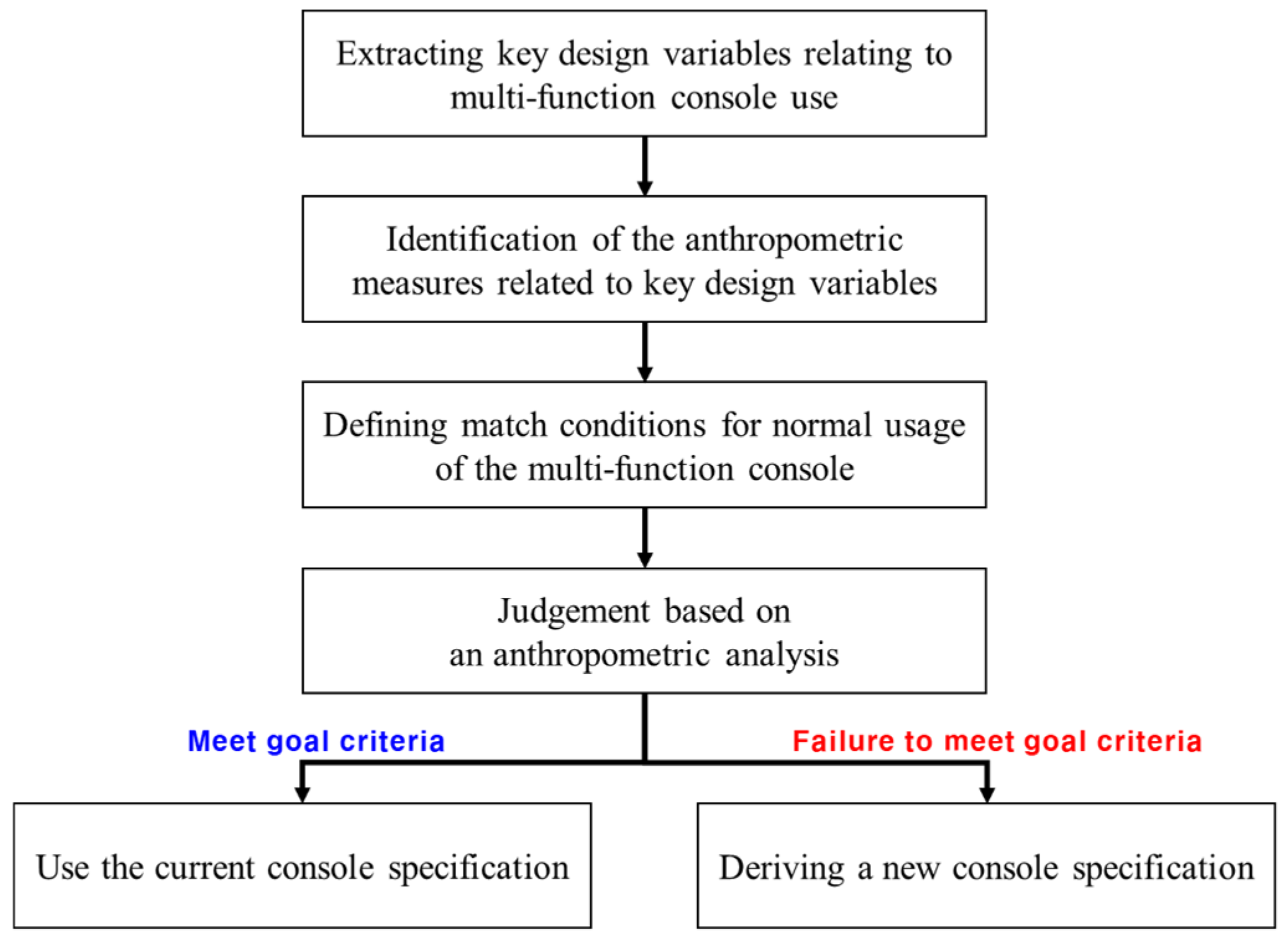

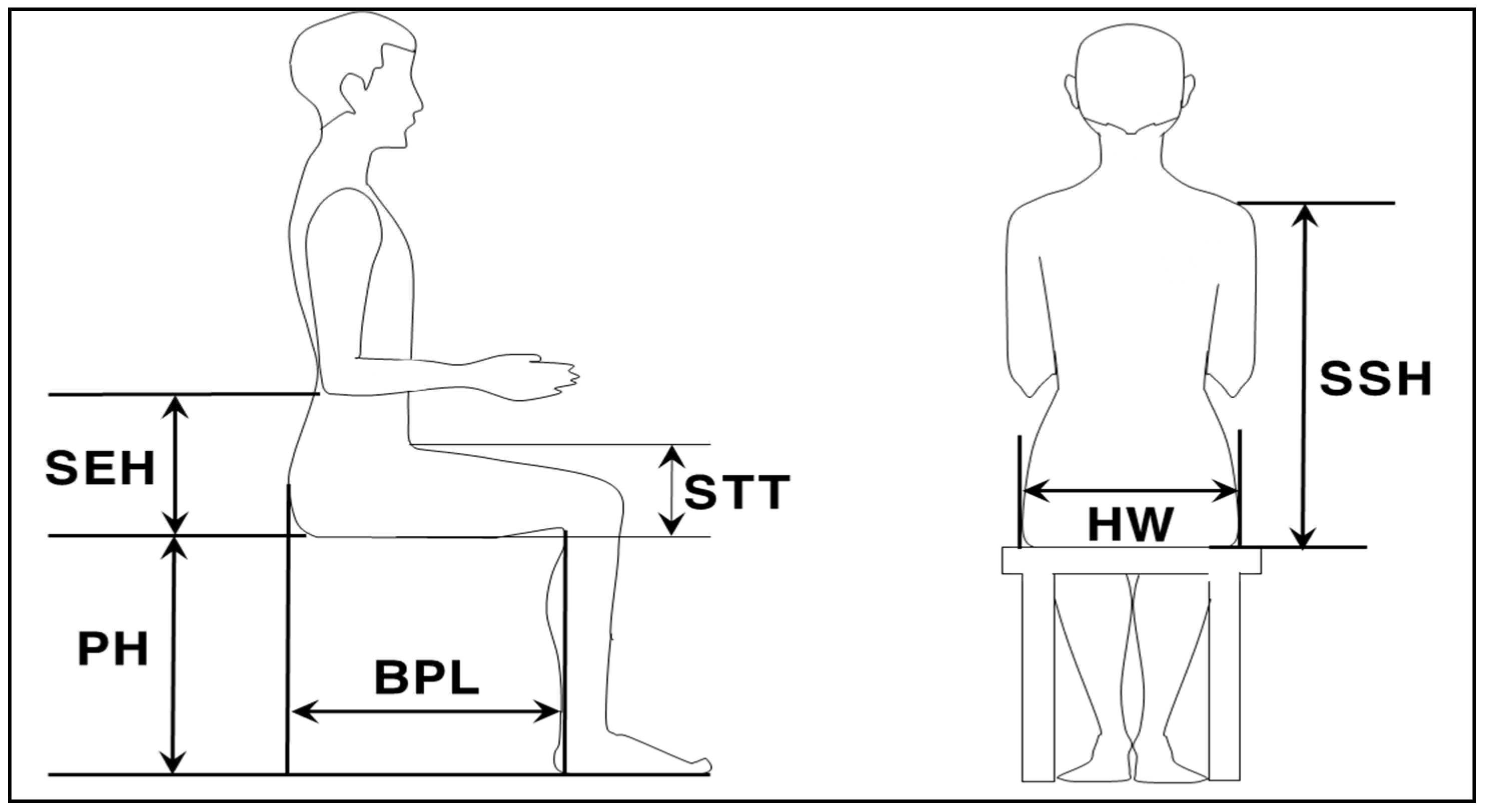
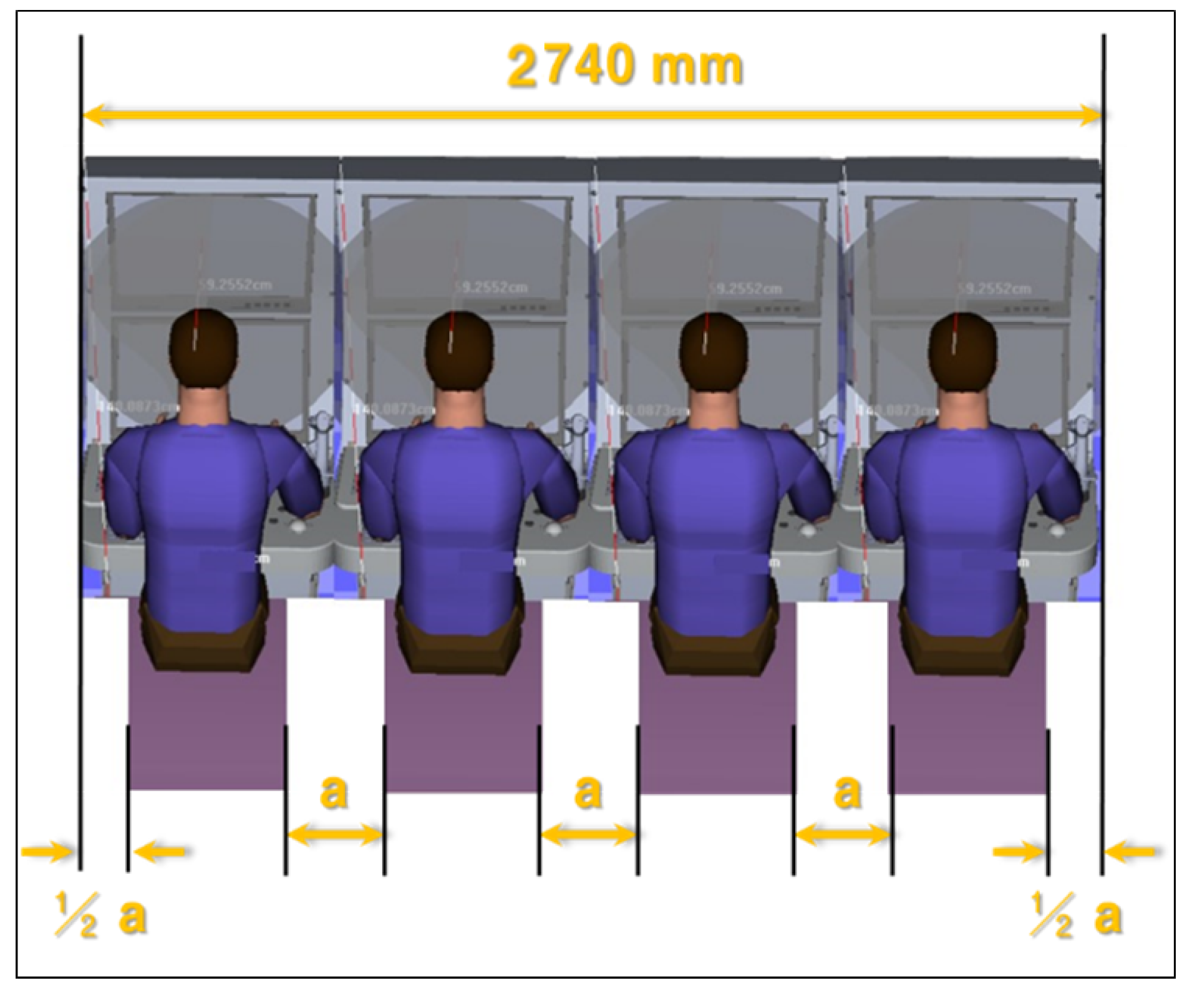
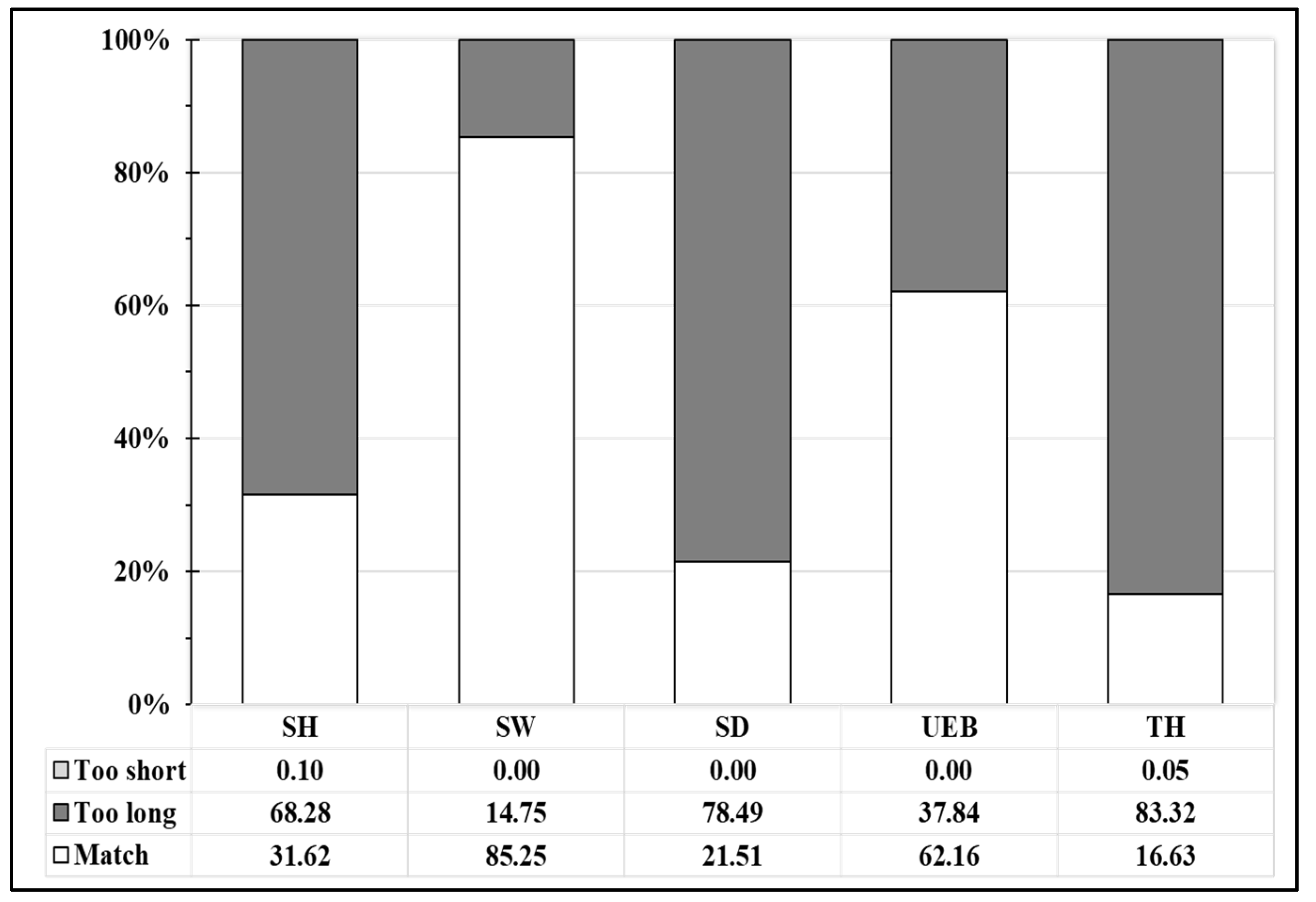
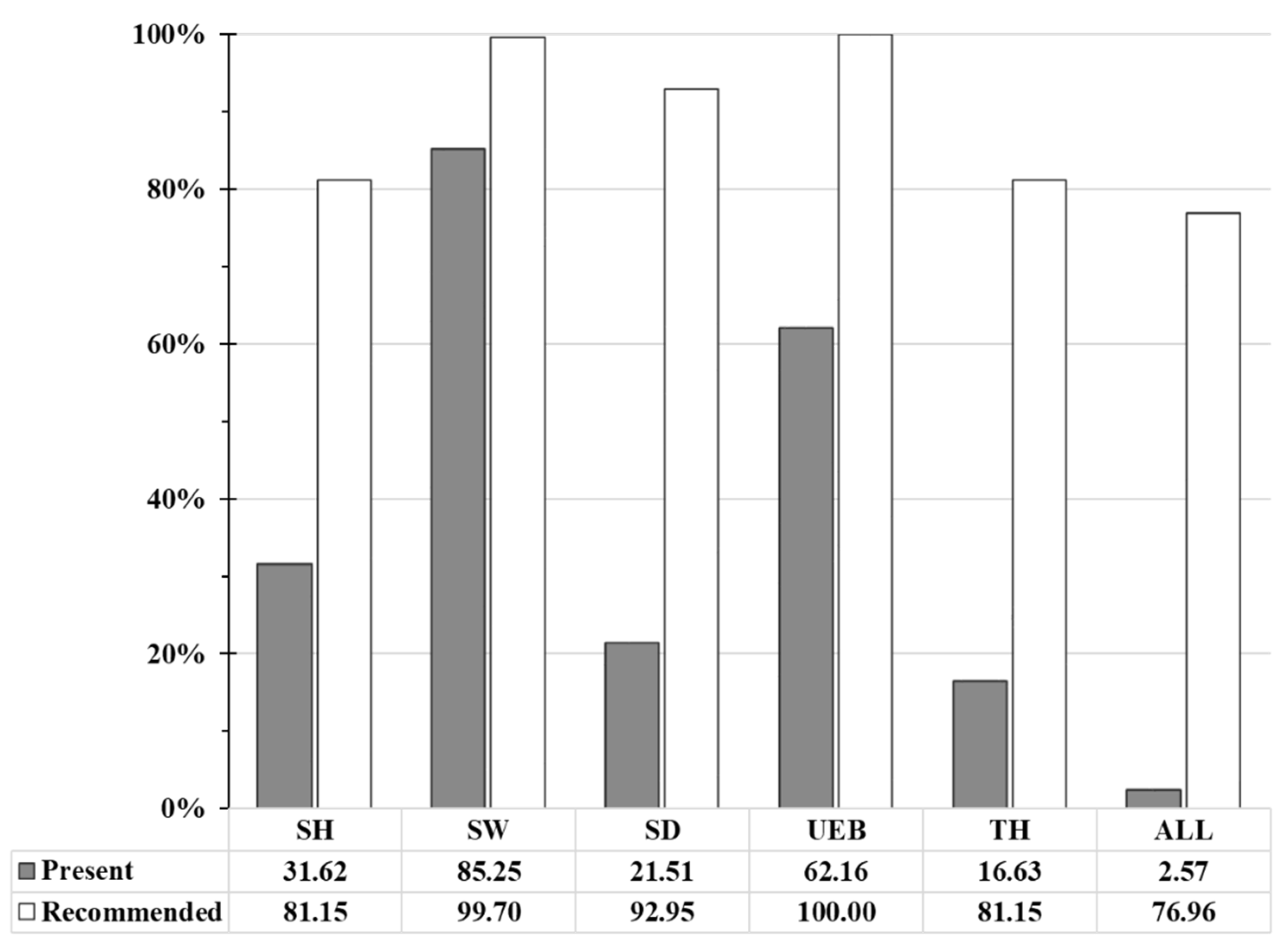
| Anthropometric Measures | Mean (n = 2027) | SD | Min | Max | Percentiles | ||
|---|---|---|---|---|---|---|---|
| 5 | 50 | 95 | |||||
| Popliteal height (mm) | 428.01 | 20.5 | 353 | 523 | 395 | 428 | 463 |
| Hip width (mm) | 355.26 | 23.5 | 287 | 475 | 320 | 354 | 394 |
| Buttock to popliteal length (mm) | 490.46 | 22.9 | 420 | 592 | 454 | 490 | 530 |
| Sitting thigh thickness (mm) | 151.20 | 14.3 | 108 | 280 | 130 | 151 | 175 |
| Sitting shoulder height (mm) | 607.39 | 25.9 | 522 | 702 | 565 | 607 | 650 |
| Sitting elbow height (mm) | 268.79 | 25.1 | 195 | 364 | 227 | 270 | 309 |
| Design Variable | SH | SW | SD | UEB | TH |
|---|---|---|---|---|---|
| Recommended Specification | 431 mm | 442 mm | 429 mm | 442 mm | 738 mm |
© 2020 by the authors. Licensee MDPI, Basel, Switzerland. This article is an open access article distributed under the terms and conditions of the Creative Commons Attribution (CC BY) license (http://creativecommons.org/licenses/by/4.0/).
Share and Cite
Lee, J.; Cho, N.; Yun, M.H.; Lee, Y. Data-Driven Design Solution of a Mismatch Problem between the Specifications of the Multi-Function Console in a Jangbogo Class Submarine and the Anthropometric Dimensions of South Koreans Users. Appl. Sci. 2020, 10, 415. https://doi.org/10.3390/app10010415
Lee J, Cho N, Yun MH, Lee Y. Data-Driven Design Solution of a Mismatch Problem between the Specifications of the Multi-Function Console in a Jangbogo Class Submarine and the Anthropometric Dimensions of South Koreans Users. Applied Sciences. 2020; 10(1):415. https://doi.org/10.3390/app10010415
Chicago/Turabian StyleLee, Jihwan, Namwoo Cho, Myung Hwan Yun, and Yushin Lee. 2020. "Data-Driven Design Solution of a Mismatch Problem between the Specifications of the Multi-Function Console in a Jangbogo Class Submarine and the Anthropometric Dimensions of South Koreans Users" Applied Sciences 10, no. 1: 415. https://doi.org/10.3390/app10010415
APA StyleLee, J., Cho, N., Yun, M. H., & Lee, Y. (2020). Data-Driven Design Solution of a Mismatch Problem between the Specifications of the Multi-Function Console in a Jangbogo Class Submarine and the Anthropometric Dimensions of South Koreans Users. Applied Sciences, 10(1), 415. https://doi.org/10.3390/app10010415





